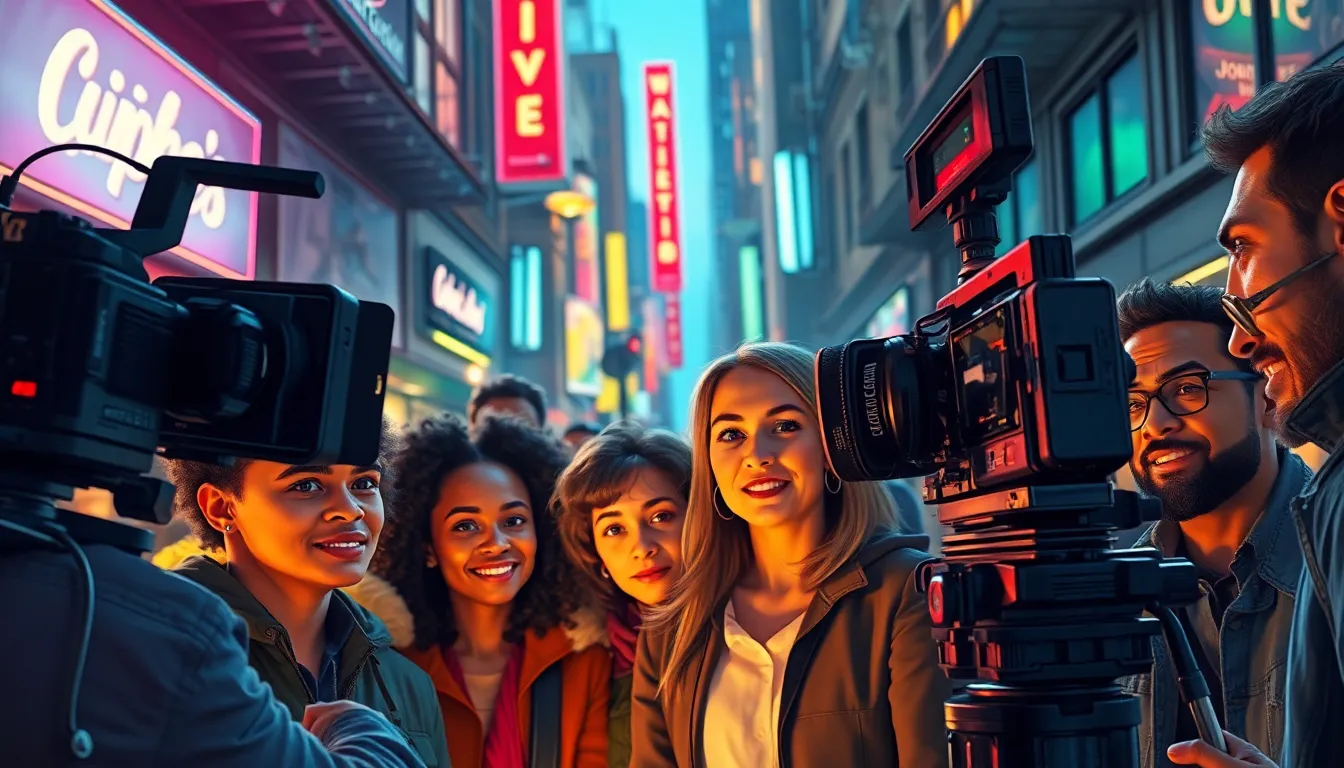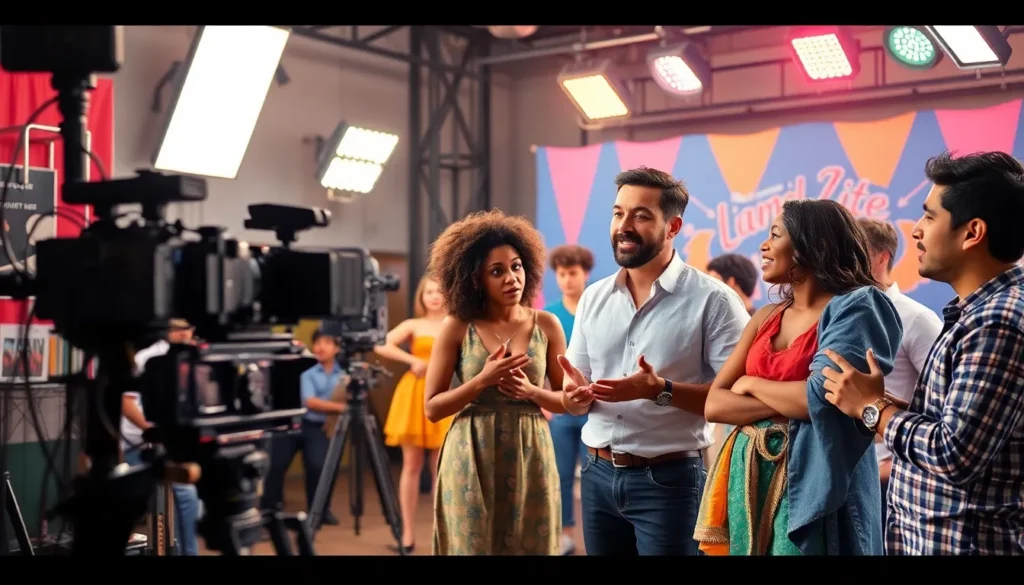Lights, camera, action! Ever wondered what makes a film tick? It’s not just about pretty faces and catchy soundtracks. The anatomy of a film is a delightful blend of creativity, structure, and a sprinkle of movie magic. From gripping story arcs to unforgettable characters, every element plays a role in captivating audiences and keeping them on the edge of their seats.
Table of Contents
ToggleOverview of Film Anatomy
Film anatomy consists of various components that contribute to the storytelling process. Narrative structure plays a crucial role; it provides the framework that guides the plot and character arcs. Engaging scripts contain dialogue and exposition that reveal character intentions and advance conflicts.
Cinematography elevates the visual storytelling experience. It encompasses shot composition, lighting, and camera movements that establish mood and tone. Editing shapes the film’s pacing, ensuring smooth transitions and maintaining audience interest throughout.
Character development is another essential element. Memorable characters possess distinct traits that resonate with viewers. Their goals and conflicts drive the narrative, creating emotional connections and enhancing viewer investment.
Sound design also contributes to the cinematic experience. It includes dialogue, sound effects, and music, all of which enhance the viewer’s immersion. An effective sound design amplifies emotional moments and underscores themes.
Production design establishes the film’s aesthetic. Art direction and costume design create visually compelling worlds, enhancing believability and drawing viewers into the story. They contribute to the overall tone and help convey themes.
Marketing and distribution strategies influence a film’s reach and success. Target audiences need clear identification, allowing filmmakers to tailor their promotional efforts. Box office performance often relies on strategic release dates and effective advertising.
Successful films blend these elements seamlessly. Each component interacts to create a cohesive and engaging experience. Understanding film anatomy improves appreciation for the art form, revealing the intricacies behind captivating stories.
Key Elements of a Film

Key elements comprise the foundation of every successful film. Understanding these aspects reveals how each contributes to the overall cinematic experience.
Story and Narrative Structure
Narratives shape the backbone of films. A well-structured plot guides audiences through a journey, featuring clear beginnings, climaxes, and resolutions. Engaging stories employ conflict to keep viewers invested and provoke emotional responses. Various techniques, like flashbacks or non-linear storytelling, can deepen intrigue, making the viewer question events. Effective storytelling intertwines character development with plot progression, enhancing audience connection.
Character Development
Character arcs transform static figures into relatable personas. Dynamic characters experience growth, allowing audiences to connect through shared struggles and triumphs. Each character’s desires, flaws, and conflicts drive narrative momentum, fostering emotional investment. Relationships among characters further enrich the story by introducing layers of complexity. Strong character development ensures viewers care about the outcomes, enhancing the overall engagement.
Visual Style and Cinematography
Visual style encapsulates the film’s aesthetic, influencing audience perception. Cinematography employs shot composition, camera angles, and lighting to convey mood and themes. Techniques like wide shots establish settings, while close-ups emphasize emotions. Color palettes can evoke specific feelings or highlight character journeys. Visual storytelling not only enhances engagement but also serves as a storytelling medium in itself, enriching the audience experience through visual context.
The Role of Sound in Film
Sound plays a vital part in film, enhancing the narrative and emotional impact. It influences how audiences perceive scenes and characters.
Music and Score
Music creates atmosphere and sets the tone. Whether it builds tension during a suspenseful moment or evokes nostalgia in a heartfelt scene, the score significantly affects emotional responses. Iconic themes often become synonymous with characters or films, making them memorable. Every note works to enhance storytelling by guiding audience reactions through crescendos and pauses. Composers collaborate closely with directors to ensure the score aligns with the film’s vision, showcasing the power of music in defining cinematic experiences.
Sound Design
Sound design involves intricate details that enrich the film’s realism. Dialogue, ambient sounds, and sound effects work together to immerse viewers in the story. Every footstep, door creak, or whispered conversation adds layers to the narrative. Skilled sound designers craft environments that resonate with authenticity, elevating moments of tension or joy. By manipulating volume and layering sounds, they create a dynamic auditory landscape. Each element contributes to a seamless blend that enhances overall storytelling, connecting audiences more deeply to the film.
Editing and Pacing
Editing plays a pivotal role in shaping a film’s narrative and maintaining audience engagement. It determines the rhythm and flow from one scene to another, ensuring that the story unfolds smoothly. Effective editing can heighten emotional impact by adjusting scene duration and arrangement, which influences pacing.
Pacing affects how audiences experience tension and excitement. A quick cut during an action sequence can create urgency, while longer takes might allow for contemplation and emotional reflection. Strong pacing keeps viewers invested in character arcs and plot developments, guiding them through the film’s emotional landscape.
Different editing techniques serve specific purposes. Montage sequences compress time and highlight key story elements, while cross-cutting builds suspense by juxtaposing simultaneous actions. Slow-motion sequences emphasize dramatic moments, adding depth to critical scenes.
Transitions between scenes contribute to a film’s overall rhythm. Smooth cuts maintain narrative continuity, while abrupt edits can provoke audience surprise or confusion. Each transition should align with the film’s tone, whether it is lighthearted or suspenseful.
Story structure influences pacing as well. Rising action boosts tension leading up to a climax, while falling action establishes resolution. Editors break down scripted scenes to determine the most effective pacing for storytelling.
Collaboration between the editor and director ensures that the final cut reflects the intended vision. Communication about pacing choices results in a film that resonates with audiences, balancing action with moments of stillness. Ultimately, skilled editing enhances both pacing and storytelling, resulting in an engaging cinematic experience.
Conclusion
Understanding the anatomy of a film reveals the intricate interplay of various elements that contribute to its success. Each component from narrative structure to sound design plays a vital role in crafting a memorable cinematic experience. By appreciating how these elements work together filmmakers can create stories that resonate deeply with audiences.
The artistry involved in filmmaking extends beyond the screen. It encompasses creativity collaboration and technical skill. Recognizing this complexity enhances viewers’ enjoyment and engagement with films. As audiences become more aware of these nuances they’re likely to develop a greater appreciation for the craft and the stories being told. This deeper understanding not only enriches the viewing experience but also fosters a lasting connection to the art of cinema.




